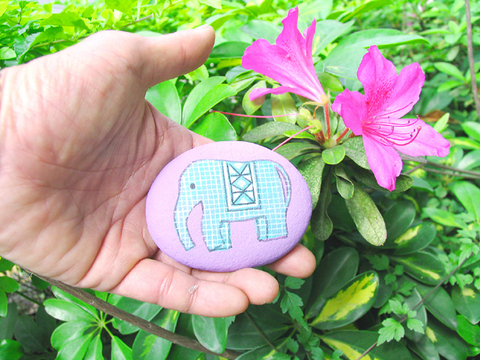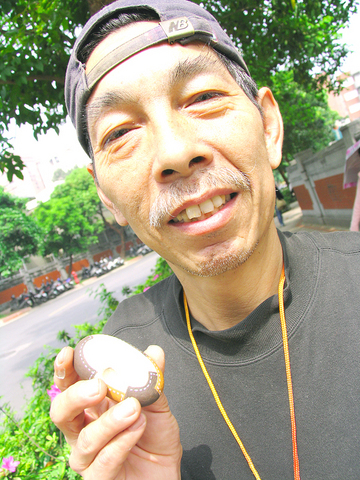He arrives on a bike, looks up at the sky and finds a place to lay down his mat. He then spreads out an assortment of colored stones and waits like a fisherman for a bite.
Locals and tourists wander past, glance at the collection, do a double take and often walk back to have a closer look, attracted by the lure of the brightly painted stones.
Wandering artist Wu Rong-bi (

PHOTOS: JULES QUARTLY, TAIPEI TIMES
He tells them that he finds the stones in Keelung, where there is a plentiful source of the flattened circular pebbles (about 3cm to 5cm in diameter) he prefers.
He says that some of the stones' designs are inspired by dreams, or are the product of his calligraphy studies. He uses bright acrylic paints. Some of them have African or Asian geometric patterns, others are figurative, with simplified forms such as an elephant or a leaf.
"Most paintings only have one plane or face," he says, "But these stones are three-dimensional art and are therefore that much more special."

Wu has been a Taipei City Government approved artist since last year, when he was given a pass that he hangs around his neck. It allows him to sell his wares on the street, in the Shida area off Hoping East Road most afternoons, or outside the Eslite store on Dunhua South Road in the evenings.
He teaches social studies to kids part time but his main income is from selling the stones, which retail from NT$300 to NT$200. He gives bonafide students 50 percent discount.
Erica Chen, a student from Texas, thought the stones were "pretty interesting. ... They're good value and great souvenirs that I can give friends when I get back home."

We lay transfixed under our blankets as the silhouettes of manta rays temporarily eclipsed the moon above us, and flickers of shadow at our feet revealed smaller fish darting in and out of the shelter of the sunken ship. Unwilling to close our eyes against this magnificent spectacle, we continued to watch, oohing and aahing, until the darkness and the exhaustion of the day’s events finally caught up with us and we fell into a deep slumber. Falling asleep under 1.5 million gallons of seawater in relative comfort was undoubtedly the highlight of the weekend, but the rest of the tour

Youngdoung Tenzin is living history of modern Tibet. The Chinese government on Dec. 22 last year sanctioned him along with 19 other Canadians who were associated with the Canada Tibet Committee and the Uighur Rights Advocacy Project. A former political chair of the Canadian Tibetan Association of Ontario and community outreach manager for the Canada Tibet Committee, he is now a lecturer and researcher in Environmental Chemistry at the University of Toronto. “I was born into a nomadic Tibetan family in Tibet,” he says. “I came to India in 1999, when I was 11. I even met [His Holiness] the 14th the Dalai

Following the rollercoaster ride of 2025, next year is already shaping up to be dramatic. The ongoing constitutional crises and the nine-in-one local elections are already dominating the landscape. The constitutional crises are the ones to lose sleep over. Though much business is still being conducted, crucial items such as next year’s budget, civil servant pensions and the proposed eight-year NT$1.25 trillion (approx US$40 billion) special defense budget are still being contested. There are, however, two glimmers of hope. One is that the legally contested move by five of the eight grand justices on the Constitutional Court’s ad hoc move

Stepping off the busy through-road at Yongan Market Station, lights flashing, horns honking, I turn down a small side street and into the warm embrace of my favorite hole-in-the-wall gem, the Hoi An Banh Mi shop (越南會安麵包), red flags and yellow lanterns waving outside. “Little sister, we were wondering where you’ve been, we haven’t seen you in ages!” the owners call out with a smile. It’s been seven days. The restaurant is run by Huang Jin-chuan (黃錦泉), who is married to a local, and her little sister Eva, who helps out on weekends, having also moved to New Taipei